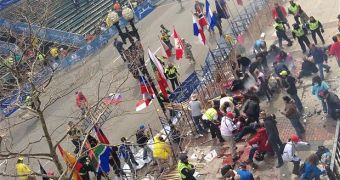Runners and witnesses at the Boston Marathon describe the war scene that followed the detonation of two bombs near the finish line of the race yesterday.
Boston Fire Department District Chief Ron Harrington describes the carnage, mentioning torn limbs and severe wounds.
“Bodies and body parts. Blood all over. A little boy lying in the street. A young woman in her twenties. Both dead. It was mayhem. I saw two people with arms hanging loose, and one without a leg.
“A shoe with flesh still in it,” he mentions.
“These runners just finished and they don’t have legs now.' [...] So many of them. There are so many people without legs. It’s all blood. There’s blood everywhere. You got bones, fragments. It’s disgusting,” adds Rhode Island state trooper and ex-Marine Roupen Bastajian.
“There were seven, eight, nine people lying on the ground. They appeared to be dead.
“Marathon runners were tearing off their shorts to use as tourniquets to help the injured,” describes Marc Hagopian, who owns a hotel located a few yards from the scene.
As we also reported, two bombs went off yesterday, killing three people and injuring some 140, 17 of which severely.
Daily Mail informs that the first explosive was detonated on Boyston Street, and the second bomb went off within 10 seconds in close proximity. A video of the event reveals the force of the blast, knocking down those at the scene.
The explosives were rigged to cause severe injuries, including ball bearings that tore apart body parts. As we relayed, the bombs went off four hours after the start of the race, possibly targeting a large number of slower, amateur runners.
The victims were transported to local hospitals with wounds caused by flying debris. Some doctors suggest that the blasts brought forward shattered pieces of rocks and other objects located on the ground, injuring runners.
“Rocks, bits of metal, soda cans, anything that is really close to a blast like that can be fragmented.
“Everything we saw was ordinary material that could have been propelled by the device,” says Dr. Ron Walls of Brigham and Women's Hospital.

 14 DAY TRIAL //
14 DAY TRIAL //